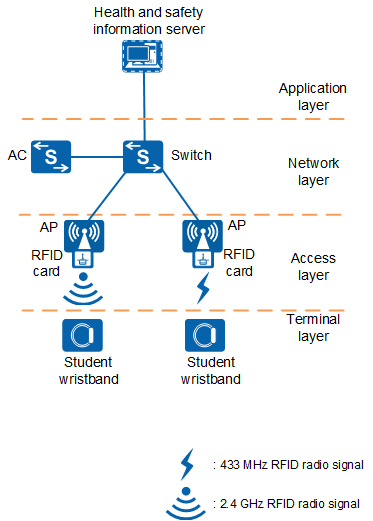Overview of the Education IoT Solution - Student Health and Safety
Scenario Overview
At schools, students' health and safety always attract attention of the schools and parents. Monitoring and query for students' health and safety information are strongly needed.
To meet these requirements, Huawei offers the Student Health and Safety Internet of Things (IoT) Solution. This solution allows schools and parents to monitor and query health and safety information about students, including the time when they enter and leave schools.
Solution Benefits
- It supports monitoring of students' physical health data and information such as heart rate, pace, and duration of sleep through student wristbands. Student wristbands can also record the time when they enter and leave schools. Big Data statistics and analytics can then be performed on the data, so that effective measures can be taken in time against abnormal situations.
- A WLAN can be reused as the student health and safety IoT network to achieve network integration, reduce network deployment and maintenance costs, and help administrators manage the network.
Network Architecture
As shown in Figure 1, the network architecture consists of the terminal layer, access layer, network layer, and application layer.
Terminal layer
Student wristbands are deployed at this layer.
Access layer
IoT APs and radio frequency identification (RFID) cards built in the IoT APs are deployed at this layer.
Network layer
Network devices such as ACs and switches are deployed at this layer.
Application layer
A server is deployed at this layer for managing student health and safety information (server for short).
Related Products
Device |
Function |
Vendor |
|---|---|---|
AP |
Provides slots for RFID cards to connect to the WLAN. |
Huawei Only the AP4050DN-E and AP7052DN can be used. |
AC |
Manages APs, delivers configurations to them, and works together with them. |
Huawei |
| Switch | It is used to build a networking structure and forward packet data on the network. |
Huawei |
| RFID card | Receives health data and information from student wristbands and reports the data to the server. | Telpo |
| Student wristband | Collects, records, and reports health and safety data and information about students, including the time when they enter and leave schools. | Telpo |
| Server | Parses and processes data and information reported from student wristbands, and sends the parsed data to a health platform. | Telpo |
